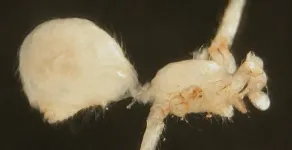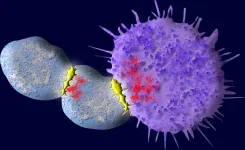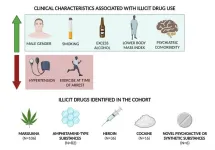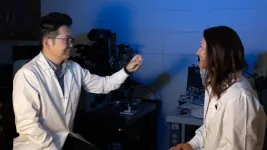(Press-News.org) Some organisms, such as tardigrades, rotifers, and nematodes, can survive harsh conditions by entering a dormant state known as “cryptobiosis.” In 2018, researchers from the Institute of Physicochemical and Biological Problems in Soil Science RAS in Russia found two roundworms (nematode) species in the Siberian Permafrost. Radiocarbon dating indicated that the nematode individuals have remained in cryptobiosis since the late Pleistocene, about 46,000 years ago. Researchers from the Max Planck Institute of Molecular Cell Biology and Genetics (MPI-CBG) in Dresden, the Center for Systems Biology Dresden (CSBD), and the Institute of Zoology at the University of Cologne, all located in Germany, used genome sequencing, assembly, and phylogenetic analysis and found that the permafrost nematode belongs to a previously undescribed species, Panagrolaimus kolymaensis. They showed that the biochemical mechanisms employed by Panagrolaimus kolymaensis to survive desiccation and freezing under laboratory conditions are similar to those of a life-cycle stage in the important biological model Caenorhabditis elegans.
When Anastasia Shatilovich at the Institute of Physicochemical and Biological Problems in Soil Science RAS in Russia revived two frozen individual nematodes from a fossilized burrow in silt deposits in the Siberian permafrost, she and her colleagues were beyond excited. After thawing the worms in the lab, a radiocarbon analysis of plant material from the burrow revealed that these frozen deposits, 40 meters below the surface, had not thawed since the late Pleistocene, between 45,839 and 47,769 years ago. At the same time, the research group of Teymuras Kurzchalia at the MPI-CBG (Teymuras Kurzchalia is now retired) was already addressing the question of how larval stages of the nematode Caenorhabditis elegans survive extreme conditions. When the team heard about the permafrost nematodes, they immediately reached out for a collaboration with Anastasia Shatilovich.
Vamshidhar Gade, a doctoral student at that time in the research group of Teymuras Kurzchalia, started to work with the permafrost nematodes. “What molecular and metabolic pathways these cryptobiotic organisms use and how long they would be able to suspend life are not fully understood,” he says. Vamshidhar is now working at the ETH in Zurich, Switzerland.
The researchers in Dresden conducted a high-quality genome assembly of one of the permafrost nematodes in collaboration with Eugene Myers, Director Emeritus and research group leader at the MPI-CBG, the DRESDEN-concept Genome Center, and the research group of Michael Hiller, research group leader at that time at the MPI-CBG and now Professor of Comparative Genomics at the LOEWE-TBG and the Senckenberg Society for Nature Research. Despite having DNA barcoding sequences and microscopic pictures, it was difficult to determine whether the permafrost worm was a new species or not. Philipp Schiffer, research group leader at the Institute of Zoology, co-lead of the incipient Biodiversity Genomics Center Cologne (BioC2) at the University of Cologne, and expert in biodiversity genomics research, joined forces with the Dresden researchers to determine the species and analyze its genome with his team. Using phylogenomic analysis, he and his team were able to define the roundworm as a novel species, and the team decided to call it “Panagrolaimus kolymaensis”. In recognition of the Kolyma River region from which it originated, the nematode was given the Latin name Kolymaensis.
By comparing the genome of Panagrolaimus kolymaensis with that of the model nematode Caenorhabditis elegans, the researchers in Cologne identified genes that both species have in common and that are involved in cryptobiosis. To their surprise, most of the genes necessary for entering cryptobiosis in Caenorhabditis elegans so-called Dauer larvae were also present in Panagrolaimus kolymaensis. The research team next evaluated Panagrolaimus kolymaensis's ability to survive and discovered that mild dehydration exposure before freezing helped the worms prepare for cryptobiosis and increased survival at -80 degrees Celsius. At a biochemical level, both species produced a sugar called trehalose when mildly dehydrated in the lab, possibly enabling them to endure freezing and intense dehydration. Caenorhabditis elegans larvae also benefited from this treatment, surviving for 480 days at -80 degrees Celsius without suffering any declines in viability or reproduction following thawing.
According to Vamshidhar Gade and Temo Kurzhchalia, “Our experimental findings also show that Caenorhabditis elegans can remain viable for longer periods in a suspended state than previously documented. Overall, our research demonstrates that nematodes have developed mechanisms that allow them to preserve life for geological time periods.”
“Our findings are essential for understanding evolutionary processes because generation times can range from days to millennia and because the long-term survival of a species' individuals can result in the re-emergence of lineages that would otherwise have gone extinct,” concludes Philipp Schiffer, one of the authors who oversaw the study. Eugene Myers adds: “P. kolymaensis's highly contiguous genome will make it possible to compare this feature to those of other Panagrolaimus species whose genomes are presently being sequenced by Schiffer’s team and colleagues.” Philipp Schiffer is convinced that “studying the adaptation of species to such extreme environments by analyzing their genomes will allow us to develop better conservation strategies in the face of global warming.”. Teymuras Kurzchalia says: “This study extends the longest reported cryptobiosis in nematodes by tens of thousands of years.”
END
Genome analysis of 46,000-year-old roundworm from Siberian permafrost reveals novel species
International research team shows that a newly discovered nematode species from the Pleistocene share a molecular toolkit for survival with the nematode Caenorhabditis elegans
2023-07-27
ELSE PRESS RELEASES FROM THIS DATE:
Tau-regulating protein identified as a promising target for developing Alzheimer’s disease treatment
2023-07-27
PHILADELPHIA – A gene encoding a protein linked to tau production—tripartite motif protein 11 (TRIM11)—was found to suppress deterioration in small animal models of neurodegenerative diseases similar to Alzheimer’s disease (AD), while improving cognitive and motor abilities, according to new research from the Perelman School of Medicine at the University of Pennsylvania. Additionally, TRIM11 was identified as playing a key role in removing the protein tangles that cause neurodegenerative diseases, like AD. The findings are published today in Science. ...
A unified theory of the lexicon and the mind: Researchers find common cognitive foundation for child language development and language evolution
2023-07-27
Cognitive and computer scientists at the University of Toronto, Universitat Pompeu Fabra and the Catalan Institution for Research and Advanced Studies have found child language development and the historical evolution of the world’s languages share a common cognitive foundation—a core knowledge base where patterns of children’s language innovation can predict patterns of language evolution, and vice versa.
Published today in Science, the paper is a first-of-its-kind step toward a unified theory of the lexicon and the mind examined across timescales. The result may also help predict how a word’s meaning may change ...
Exposure to like-minded sources on Facebook is prevalent but did not increase polarization during the 2020 U.S. election
2023-07-27
People often debate whether social media creates "echo chambers" by showing users content that matches their politics and in turn increases polarization. A new study published today in the journal Nature reports that reducing Facebook users' exposure to content from politically "like-minded" sources had no measurable effect on their political beliefs or attitudes during the 2020 U.S. presidential election.
The findings are part of a broader research project examining the role of ...
From Down Under to Underground: surprising daddy long-legs spiders discovered in Australia and Réunion
2023-07-27
Australia’s rich and diverse fauna never fails to surprise us, as a new spider species has been documented from the continent.
The novel species, a blind daddy long-legs, was found in boreholes in the arid Pilbara of Western Australia. It is the first cave-adapted daddy long-legs spider reported from the continent, with other blind species of its genus so far only found in Thailand, Laos, and Vietnam.
“It represents a subfamily that was previously thought to be restricted to the tropical north and east of the continent,” says Bernhard Huber, one of the authors of a recent study published ...
Geological Society of America announces 2023–2024 Fellows for Science Policy and Communication
2023-07-27
27 July 2023
Geological Society of America
Release No. 23-28
Contact: Justin Samuel
+1-303-357-1026
jsamuel@geosociety.org
Boulder, Colo., USA: GSA is pleased to welcome three exceptional new Fellows who will join us in our mission to advance geoscience knowledge and discovery through excellent writing, research, and advocacy.
GSA’s 2023–2024 Science Communication Fellow is Arianna Soldati.
Soldati is an assistant professor of volcanology at North Carolina State University. Her lab group works on a variety of topics, ranging from effusive eruptions to critical minerals. She received her Ph.D. in geological sciences from the University of ...
Tail spin: Study reveals new way to reduce friendly fire in cell therapy
2023-07-27
New Haven, Conn. — In a promising form of immunotherapy known as CAR T-cell (chimeric antigen receptor) therapy, the patient’s T cells are engineered to better recognize and attack antigens on the surface of cancer cells. In treatments currently approved for use in battling lymphoma and leukemia, however, the therapy has a drawback: Amidst the cancer-killing frenzy, many engineered T cells become tainted with the remnants of cancer antigens, which causes them to turn on other T cells. This eventually depletes the body of cancer-fighting cells ...
Research Corporation for Science Advancement (RCSA) chooses Symplectic Grant Tracker to manage funding for innovative scientific research
2023-07-27
Digital Science, a technology company serving stakeholders across the research ecosystem, is pleased to announce that the Research Corporation for Science Advancement (RCSA) has chosen Symplectic Grant Tracker from Digital Science’s suite of flagship products to advance its aims of providing catalytic funding for innovative scientific research and the development of academic scientists.
RCSA joins the 50+ foundations, charities and funders worldwide who manage their end-to-end grant lifecycle using Symplectic Grant Tracker. Designed from the outset to meet research funding needs, Grant Tracker includes features to assist applicants, reviewers, committees and ...
Investigators identify translation gaps in instrument that measures nursing practice environment
2023-07-27
PHILADELPHIA (July 27, 2023) – Two decades ago, the Practice Environment Scale of the Nursing Work Index was published to measure the nursing practice environment. Although the instrument's use has resulted in advances in science and quality improvement efforts, its potential may be limited by the availability and quality of translations into different languages.
Researchers from the University of Pennsylvania School of Nursing (Penn Nursing) investigated published translations of the instrument and have identified ...
Illicit drug use is involved in nearly one in three sudden cardiac deaths in young adults
2023-07-27
Philadelphia, July 27, 2023 – Approximately one-third of young adults in Victoria, Australia, who experienced sudden cardiac deaths (SCDs) outside of a hospital setting from April 2019 to April 2021 used illegal drugs prior to their fatal events, reports a new study in Heart Rhythm, the official journal of the Heart Rhythm Society, the Cardiac Electrophysiology Society, and the Pediatric & Congenital Electrophysiology Society, published by Elsevier. The analysis of data on substance abuse, revealed through positive toxicology reports and patient histories and recorded in one of the world’s largest and most comprehensive SCD registries, ...
$3 million grant awarded to MU researcher for leading biomedical and agricultural innovation
2023-07-27
In a new study funded by a $3 million grant from the National Institutes of Health (NIH), University of Missouri researcher Kiho Lee, an associate professor in the College of Agriculture, Food and Natural Resources, will use gene editing to investigate the building blocks of disease. His ultimate goal — to discover clinically significant explanations for human diseases like Alzheimer’s, cancer and infertility, while working on solutions to global food insecurity.
Common diseases, such as Alzheimer’s, are widespread in humans, plaguing an estimated 11% or 6.7 million Americans over age 65, according to The ...
LAST 30 PRESS RELEASES:
New modeling approach sheds light on rare gut disease
Study documents potentially hazardous flame retardants in firefighter gear
Can certain bacteria regulate aging of the immune system and its related alterations?
AI model helps diagnose often undetected heart disease from simple EKG
There are fewer online trolls than people think
Cell membrane fluctuations produce electricity
Jeonbuk National University study shows positive parenting can protect adolescents against self-harm
Surface-engineered ZnO nanocrystals to tackle perfluoroalkyl substance contamination
This new understanding of T cell receptors may improve cancer immunotherapies
A new fossil face sheds light on early migrations of ancient human ancestor
A new immunotherapy approach could work for many types of cancer
A new way to diagnose deadly lung infections and save lives
40 percent of MRI signals do not correspond to actual brain activity
How brain-inspired algorithms could drive down AI energy costs
Gum disease may be linked to plaque buildup in arteries, higher risk of major CVD events
Contrails are a major driver of aviation’s climate impact
Structure of dopamine-releasing neurons relates to the type of circuits they form for smell-processing
Reducing social isolation protects the brain in later life
Keeping the heart healthy increases longevity even after cancer
Young adults commonly mix cannabis with nicotine and tobacco
Comprehensive review illuminates tau protein's dual nature in brain health, disease, and emerging psychiatric connections
Book prepares K-12 leaders for the next public health crisis
Storms in the Southern Ocean mitigates global warming
Seals on the move: Research reveals key data for offshore development and international ecology
Sports injuries sustained during your period might be more severe
World's first successful 2 Tbit/s free-space optical communication using small optical terminals mountable on satellites and HAPS
Can intimate relationships affect your heart? New study says ‘yes’
Scalable and healable gradient textiles for multi‑scenario radiative cooling via bicomponent blow spinning
Research shows informed traders never let a good climate crisis go to waste
Intelligent XGBoost framework enhances asphalt pavement skid resistance assessment
[Press-News.org] Genome analysis of 46,000-year-old roundworm from Siberian permafrost reveals novel speciesInternational research team shows that a newly discovered nematode species from the Pleistocene share a molecular toolkit for survival with the nematode Caenorhabditis elegans







